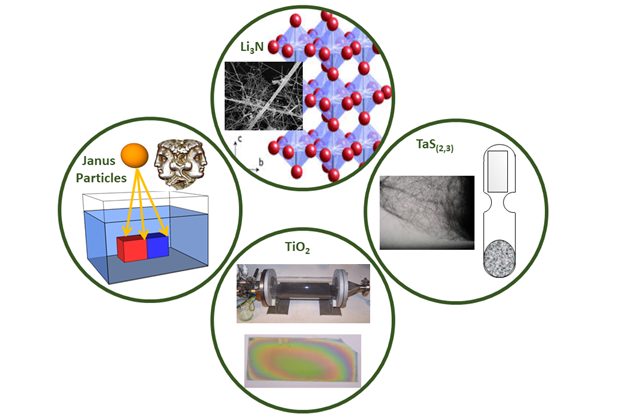Video Article Open Access
Advanced Materials and Me: A Fellows Perspective
Charles Dunnill
Swansea University, Energy Safety Research Institute, Bay Campus, Fabian way, Swasnea SA1 8 EN UK
Vid. Proc. Adv. Mater., Volume 2, Article ID 2108200 (2021)
DOI: 10.5185/vpoam.2021.08200
Publication Date (Web): 13 Sep 2021
Copyright © IAAM
Graphical Abstract

Abstract
This lecture will detail my career to date as a materials scientist looking at a few of the significant syntheses and characterizations of some advanced materials. From the beginnings of a “Crazy” preparation to where I am now with some interesting discoveries along the way. We will look at the materials that have shaped my career and the scientific papers that have resulted from them. Starting with Lithium Nitride preparations as nanofibers. Here we will explore the synthesis firstly of Li3N bulk utilizing a highly reactive solid state method whereby pure metallic sodium is used as a solvent to dissolve metallic lithium and react it with nitrogen to form the nitride in it’s purest form, which is then subsequently transformed into nanofibers utilizing a chemical vapor transport method [1]. The second set of materials are the materials I worked on during my PhD where we had low dimensional conductors of different transition metal chalcogenides. In particular we will look at TaS2 and TaS3 and their potential syntheses and transitions into oxides and nitrides [2]. Moving forward into TiO2 photocatalysts and the N doping dilemma and how we solved for nitrogen doping in either the interstitial or the substitutional site leading to enhanced photocatalysis [3]. The TiO2 work transitioned into Janus particle work where we were trying to marry a hydrogen catalyst with an oxygen catalyst in the same nanoparticle initially with similar phases such as anatase and rutile forms of TiO2 [4] before moving to biphasic systems such as WO3 and Ta3N5.
Keywords
Nanomaterials; photocatalysis; hydrogen.
Acknowledgement
I acknowledge Ramsay memorial trust for the 3 years of funding for Ramsay Fellowship along with the welsh government for current funding and of course my research group at Swansea for all their contributions.
References
- Tapia-Ruiz, N.; Gordon, A. G.; Jewell, C. M.; Edwards, H. K.; Dunnill, C. W.; Blackman, J. M.; Snape, C. P.; Brown, P. D.; MacLaren, I.; Baldoni, M.; Besley, E.; Titman, J. J.; Gregory, D. H., Nature Communications 2020, 11 (1), 4492.
- Dunnill, C. W.; MacLaren, I.; Gregory, D. H.Nanoscale 2010, 2 (1), 90-97.
- Dunnill, C. W. H.; Aiken, Z. A.; Pratten, J.; Wilson, M.; Morgan, D. J.; Parkin, I. P. J. Photochem. Photobiol. A-Chem. 2009, 207 (2-3), 244-253.
- Scanlon, D. O.; Dunnill, C. W.; Buckeridge, J.; Shevlin, S. A.; Logsdail, A. J.; Woodley, S. M.; Catlow, C. R. A.; Powell, M. J.; Palgrave, R. G.; Parkin, I. P.; Watson, G. W.; Keal, T. W.; Sherwood, P.; Walsh, A.; Sokol, A. A. Nature Materials 2013, 12, 798.
Biography
Charles Dunnill heads up the Sustainable Hydrogen Innovation and Technology Group at Swansea and has interests in the use of hydrogen as an alternative energy vector. Charlie got his PhD from Glasgow University studying nanoscale chalcogenide materials and then went on to do 6 years in London at UCL as a post-doc and Ramsay Fellow, before moving to Swansea as a senior lecturer in the energy safety research institute as part of the college of engineering. Charlie runs a research group of 12 with post-doctoral researchers and PhD’s whilst collaborating with industry on hydrogen related projects as part of 3 large welsh government initiatives, FLEXIS, RICE and project DESIRE. Charlie has a wealth of experience in functional and advanced materials including nanomaterials and photocatalytic functional materials both for water cleaning and water splitting. Charlie has published 83 papers with an h index of 29 and is a Chartered Scientist and Chemist. He spends his spare time Beekeeping and playing canoe polo, which is likened to 5 a side rugby in boats with hitting sticks.
Video Proceedings of Advanced Materials

Upcoming Congress



